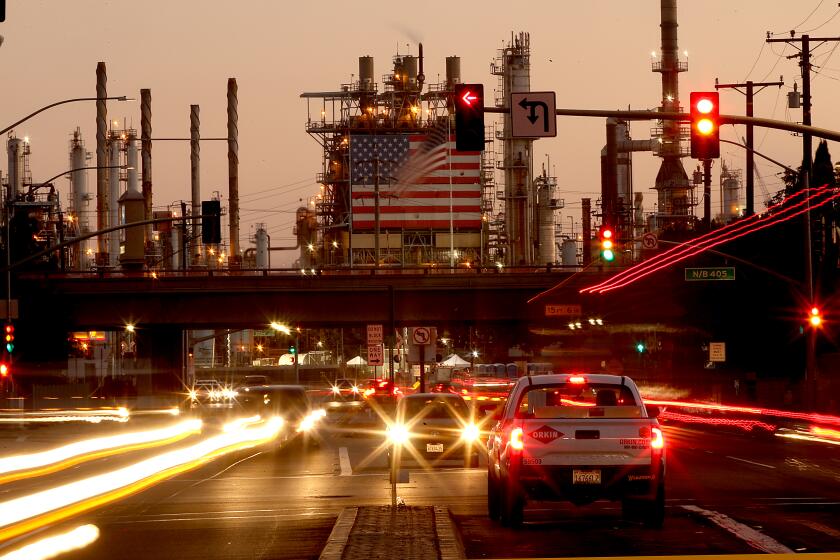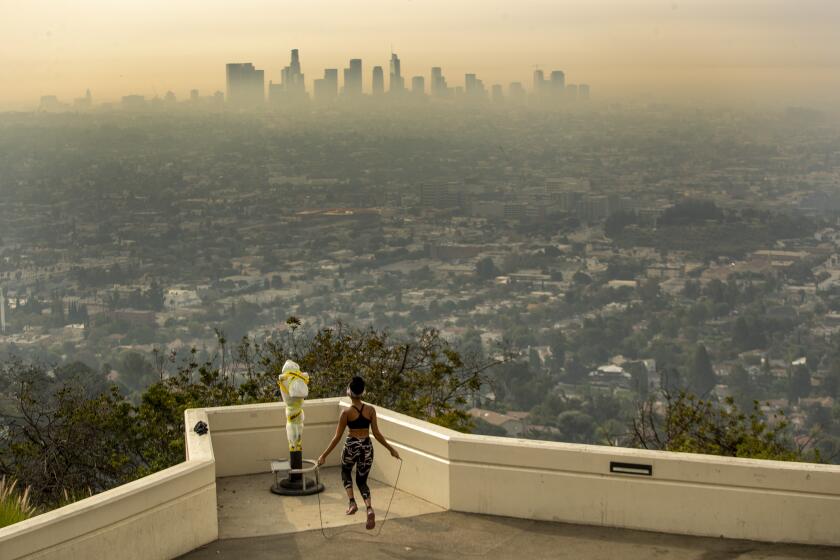Air regulators threaten Southern California warehouses with fines

- Share via
Southern California air regulators announced Wednesday they will launch a sweeping enforcement initiative aimed at large warehouses that have resisted a new pollution reduction program for months.
In 2021, the South Coast Air Quality Management District adopted a first-of-its-kind rule that requires large warehouses to offset pollution from the truck traffic they attract. Operators could mitigate these emissions by taking a range of actions, such as installing solar panels or using zero-emission yard trucks. Otherwise, they would need to pay a fee.
However, this March was the first major deadline for the region’s largest warehouses to submit compliance reports. Only 45% of the 1,019 affected facilities responded.
“Time is up for those not complying with our rule,” said Wayne Nastri, South Coast AQMD executive officer. “Owners and operators of warehouses have known about these deadlines for two years. Communities near these facilities deserve to breathe clean air and our enforcement teams will work quickly to ensure that the facilities come into compliance as quickly as possible.”
Warehouses that fail to register with the agency could face financial penalties as high as $11,710 for each day they fail to come into compliance. The enforcement action will begin with warehouses operating in disadvantaged communities.
In the last decade, hundreds of developers of colossal warehouses have sought to gain a foothold in Southern California’s bustling hub of goods movement, especially in San Bernardino and Riverside counties. Today, the heavy-duty trucks and cargo-moving equipment that operate at the region’s major warehouses contribute nearly as much smog-forming emissions as refineries, power plants and other heavy polluters combined, according to air district officials.
The air district’s warehouse rule aims to curtail these emissions by 10% to 15% over five years. Warehouses that fall short of the goal must pay a mitigation fee, which the air district could invest in clean air projects.
By 2025, all warehouses over 100,000 square feet will be subject to the rule.
Southern California air regulators adopted a rule that has forgiven more than $200 million in pollution fees from facilities that emit smog-forming chemicals.
So far, the program has raised about $9 million and reduced smog-forming nitrogen oxides by 3%, according to air district officials.
The warehouse compliance reports submitted to the air district included annual truck traffic, warehouse size and how these facilities chose to offset emissions.
The information would have provided the public with insight into the traffic these facilities generate. However, roughly one-third of owners and operators, including Amazon, requested their reports and data be kept confidential.
Among those warehouses that did report their traffic publicly, the largest traffic was an 830,000-square-foot UPS facility in Ontario that hosted 933,000 heavy-duty truck trips in 2022, according to a Times records request. The facility met its required emissions reductions through its acquisition and use of so-called near-zero-emission big rigs.
Air district officials contend the facilities that have complied with the program have exceeded expectations.
Even so, 25% of warehouses that have submitted reports opted to pay fees instead of implementing clean air actions. A 666,000-square-foot Home Depot distribution center in Ontario hosted more than 82,000 heavy-duty truck trips. It opted to pay nearly $170,000 in pollution mitigation fees.
The fees are expected to be used to fund emission reduction projects within communities, regulators say.
The enforcement action comes as the air district is preparing similar pollution rules for the ports of Los Angeles and Long Beach. The port complex is the largest single source of nitrogen oxides in the region, the air district says.
The agency was also considering new rules for rail companies but may now enter into a memorandum of understanding with Union Pacific and BNSF Railway.
Environmental groups have urged that all sectors of the logistics industry — warehouses, rail and ports — be regulated by enforceable rules, and not memorandums of understanding.
“The AQMD has a moral and legal obligation to protect our communities and regulate the air quality,” said Ivette Torres, a policy expert and advocate with the People’s Collective for Environmental Justice. “We don’t have time to keep waiting for the industry to voluntarily do the right thing.”
Earlier this year, the California Air Resources Board adopted landmark rules that would ban new gas- and diesel-powered trucks starting in 2036.
But residents and environmental groups still worry about the pollution they might have to endure in the coming decades.
Long-term exposure to fine particulate pollution may increase the risk of developing dementia, new research says.
Ana Gonzalez, executive director of the Center for Community Action and Environmental Justice, grew up in the Inland Empire and remembers when much of the area was vineyards and orange groves. Much of the farmland and residential areas have been rezoned and replaced by sprawling warehouses, where diesel trucks queue and idle.
This pollution has contributed to San Bernardino’s designation as the smoggiest county in the nation. Gonzalez said the pollution contributes to disproportionate rates of childhood asthma, missed days of school and expensive medical bills. Her 17-year-old son, who has asthma, has been admitted to the hospital several times in recent years with respiratory illnesses.
“Just recently he had bronchitis, and he still has a cough and is recovering a month later,” she said. “And then our schools wonder why kids are missing school. These are the exact impacts that we are talking about. Our kids are suffering daily with different types of lung issues, and I’ve experienced it personally.”
Gonzalez and other Inland Empire residents have fought against building more of these facilities, with mixed success. She is appealing a decision to site a large warehouse less than 100 feet from her Rialto home.
But even as she works to stop warehouse expansion, she said it’s going to take enforcement from the air district to rein in pollution at the facilities that already exist. The compliance data, she said, show that the current approach isn’t working.
“You have to protect human health,” Gonzalez said. “And you have an amazing tool in your toolbox to say, ‘If you’re not going to comply, we’re going to shut you down. You do not have the right to harm our community, period.’
“I wish they would have a stronger stance on that.”











